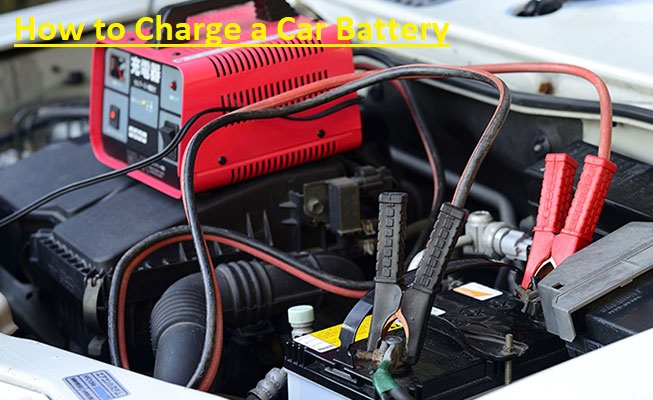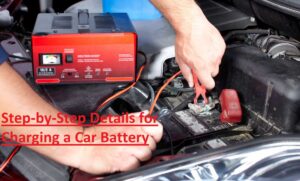Car batteries are the main part of a car that controls the car’s different operations. There are different processes involved for charging a battery. Here, we will cover the detailed features of car battery charging. So let’s get started with How to Charge a Car Battery at Home
Car Batteries Working
- Normally, a car operates on 12-volt lead-acid batteries used for energy to start the engine. When running, the alternator gets power to top up the battery operation and provides power to the vehicle’s electrical system.
- The battery also gives power when the engine is off, keeping the alarm working and the radio preprogrammed clock operating.
- With time, batteries lose charge-holding features, and mostly harsh conditions lose more charges.
How to Charge a Car Battery
- Charging of a conventional 12-volt lead-acid car battery is a fast solution normally performed. Currently used electric vehicle packs operate high-voltage lithium batteries that use different tools.
Tools for battery charging
Before charging the battery, there is a need for some tools that are listed here.
Smart battery charger (12V)
- First of all, arrange 12-volt charger smart features that are safer to operate than older types and avoid overcharging.
Safety gear
- Use safety glasses and gloves for protection from acid splashes and sparks.
car’s owner’s manual
- For battery type confirmation and charge rate, use the manual of the battery.
A wire brush and baking soda mixture
- For cleaning the corrosion of the terminals of the solid connection, use a cleaner.
Digital multimeter
- Digital multimeter used for checking battery voltage before charging and after charging
Step-by-Step Details for Charging a Car Battery
Follow these steps for charging a car battery.
Park the car.
- First, turn off the car ignition, use the handbrake, and open the bonnet in a well-ventilated area. When battery charging starts, flame-like hydrogen gases are released.
Inspect battery.
- First of all, inspect the battery. If you see a crack or leaking fluid, do not charge the battery; get the services of a professional.
Disconnect the battery.
- If the charger or car manual referred to removing the battery, make sure to disconnect the negative pin first, then the positive.
Clean the terminals.
- for cleaning, Use a wire brush and a baking soda solution that removes corrosion. Remove water moisture from charger clamps to provide a strong connection.
Set up the charger.
- Use a 12-volt and low-amp setting that gives slow, safe charging. not perform fast charging mode which reduces battery working life
charger connection
- Make a connection of the red clamp with the positive terminal and the black clamp with the negative pin.
Start charging.
- Now switch on the charger, and it starts working. A standard 48 Ah battery takes about four to 12 hours for charging at 4A.
Switch off
- WHEN you make sure that the battery is completely charged, first turn off the switch, then remove the black clamp, and then the red clamp.
Reconnect and tighten.
- Now again connect the battery cables, first connect the positive cable, then the negative. Tighten clamps, without over-tightening.
Check the charge.
- Now use a multimeter to make sure that it is 12.6 volts. Voltage less than 12.4 requires more charging.
Charge a Car Battery without a Charger
read also; Solex Carburetor: iFunctionality, Construction, and Benefits
- If you are stuck in a parking or at a distance from home and need to charge, follow these steps for charging without a battery charger.
Portable Jump Starter
A portable jump starter is an easy method for charging a car. That is a compact, rechargeable power pack that charges batteries instantly.
- First of all, check the jump starter charging level; normally, a unit requires about 75 percent charging for proper working.
- Connect the clamp accurately by making a connection of the red clamp with the positive battery pin and the black clamp with the negative terminal.
- Now on the power of the jump starter, click the start button, then start the car. Do not crank the engine for more than five seconds.
- When the car gets started, idle it for 2 to 3 minutes before removing the clamping in reverse order.
This technique provides enough power to start a car.Now you can drive more than 30 minutes to reach points where you can get regular charging.
charge with another car and jumper cables
In case you do not have a jump starter, you can help another car and set of jumper cables for charging. Follow these steps for charging through this process.
- First, park both cars nose to nose, turn off both ignitions, and apply both cars’ handbrakes.
- Now make the connection of the jumper cable through this sequence.
- red clamp with flat positive battery pin,
- rd clamp with second car positive terminal,
- black clamp with the 2nd car’s negative (-) terminal.
- black clamp to cleaning, unpainted metallic surface on the engine block ofa car through a dead battery
- Now start the donor car and wait for a minute to give a power supply to the flat battery.
- Now start the car with the flat battery; when starting, it takes some time to idle.
- Now disconnect cables in reverse sequence and start the engine for 20 minutes so the alternator recharges the battery.
read related guides; Filling Battery With Water: How to Add Water to Car Battery
FAQ:
Is it possible to charge a car battery without disconnecting it?
- Yes, we can charge the car battery without disconnection, and it is safe if performed accurately. Before that, check that your car is in the off state and all devices are unplugged. Make a connection of the red clamp with the positive and the black with the negative for controlling sparks.
How much does it take to charge a dead car battery?
- for dead battery, charging left it for a more complete night charging at low ampere to avoid pressure on battery cells. but it can damage the battery if it gets highly charged.
How to charge a battery at home?
- For charging purposes, use a battery charger and outlet. Find the vehicle battery pins, make sure the charger is unplugged, connect the charger with the battery, connect it and turn it on, and set accurate settings.
Is it safe to use a home battery system to charge a car battery?
- Yes, it is safe to use a home battery system for car battery charging. For this, use the required tools and do proper installation and working process for the home battery and car charging system.
How often should I charge a battery in a parked car?
- For a parked car that is not regularly driven, charge the battery for 2 to 3 weeks for proper battery health. This battery suffers from high discharge, like in cold weather, or if the car comes with electronics, then it slowly drains power.
- For short-term parking, no charging is needed for the car. If the car is parked for 2 to 4 weeks, use a smart charger.
- If parking for more than a month, use a trickle charger to keep the battery topped up automatically.
Does a solar battery charge the car?
- No solar battery to charge the car battery. Car batteries require a certain voltage range, that is, 13.8 to 14.4 V. That solar battery does not provide safety. For accurate working, connect a smart charger; use a solar charge controller for solar battery output regulation.
- Charger control voltage and charge the car battery without damage.
read also;Car Air Conditioning System Diagram
Can I charge a car battery using a home inverter?
- We can charge a car battery with an inverter. Normally, a home inverter rating is 12 volts and comes with a charging circuit for recharging the battery with 13 to 14 volts.
- For car batteries, the rating is 12 volts, and recharging with alternator voltage is 13–14 volts.
What is the cheapest way to charge an electric vehicle?
- If you have a garage, install a certain charging point. That is a low-cost option for charging EVs. If needed to connect an EV charging point at home, there needed to be a charging point.
Can I charge my EV at home with a regular outlet?
- Charging an EV at home comes with two options: a standard 120V outlet and a high-power 240V outlet. the use of a regular household outlet, a car gets 3-5 miles of range per hour.







